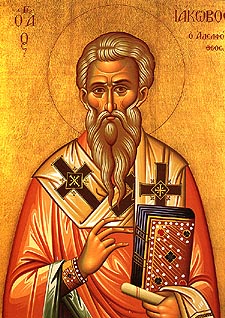|
From
among the Holy Ones commemorated on the 28th of December, we especially remember the Righteous James, the Brother
of the Lord.

The Holy Apostle James, Brother of the Lord,
was the eldest son of Joseph the Betrothed from his first marriage with Solomonia. The Apostle James is remembered after the
Feast of the Nativity of Christ together with his father Joseph and the Prophet-King David, since he accompanied his family
on the Flight into Egypt and lived there with the Infant Jesus, the Mother of God and Joseph. Later, he returned to Israel
with them. After the Ascension
of the Lord, Saint James was the first Bishop of Jerusalem, gaining the great esteem not only of Christians, but also of Jews.
He was thrown from the roof of the Jerusalem Temple because he had publicly preached to the people about the God-Manhood of
the Lord Jesus Christ. The Holy Apostle James is also commemorated on October 23.
|

